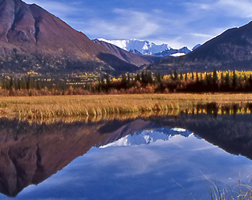The 15 national parks in Alaska are home to the United States' tallest mountains and biggest glaciers and some of its most exotic wildlife. Alaska contains the country's six largest national parks: Wrangell-Saint Elias, Gates of the Arctic, Denali, Lake Clark, Katmai, and Glacier Bay.
Of the 20 highest mountains in the United States, 17 are in Alaska: Mount McKinley, North America's largest mountain at 20,320 feet, is a defining highlight in Denali National Park and Preserve and Preserve. The second tallest mountain, Mount Saint Elias 18,008 feet, is located in Wrangell-Saint Elias National Park and Preserve, a park characterized by remote mountains, valleys, and wild rivers, all rich with wildlife.
Glacier Bay National Park and Preserve is just one of the areas in which visitors can find examples of geological phenomena. Since it was first seen by British explorer George Vancouver in the 1790s, the wall of ice that shadows Glacier Bay has retreated about 60 mi. Harding Icefield and forested coastal fjords are the highlights of Kenai Fjords National Park. Spectacular scenery stretches across the Lake Clark National Park and Preserve from the Cook Inlet to the Chigmit Mountains, which include two active volcanoes, Mount Redoubt and Mount Iliamna.
More evidence of Alaska's natural history can be found at Valley of Ten Thousand Smokes, where steam rises from a few active volcanic vents at Katmai National Park and Preserve. In the Aniakchak National Monument and Preserve, the Aniakchak River cascades through a gash 1600 ft long at the rim of a volcano crater.
Alaska's national parks also preserve the state's rich cultural history. The Bering Land Bridge National Preserve is a remnant of the land bridge that once connected Asia with North America, the route the earliest residents took to the continent. Cape Krusenstern National Monument contains archaeological sites that illustrate Eskimo communities dating back some 4000 years. Sitka National Historical Park commemorates the Battle of Sitka, the only armed conflict between Alaskan natives and Europeans. Relics of the 1898 gold rush are preserved at the Klondike Gold Rush National Historical Park and the Yukon-Charley Rivers National Preserve.
Several parks embody the state's nickname The Last Frontier because of their remote locations. They are generally accessible only by chartered planes and recommended only to those adventurers who are confident in their outdoor survival skills. Lying entirely north of the Arctic Circle, Gates of the Arctic National Park and Preserve, the northernmost extension of the Rocky Mountains, is the second largest national park in the United States. The Great Kobuk Sand Dunes are located in the Kobuk Valley National Park. A rich array of Arctic wildlife can be found in this park and the neighboring Noatak National Preserve, including caribou, grizzly and black bear, wolf, and fox
Alaska's Tongass and Chugach National Forests are America's first and second largest national forests, respectively. While both parks share public services such as easy access, camping, trails, interpretive centers, and hunting and fishing, each has a unique flavor determined by its landscape and wildlife.
The Tongass National Forest, covering Alaska's Panhandle region, has nearly quadrupled in size since it was established in 1902, today encompassing about 17 million acres. Because of its size, the Tongass is divided into three areas: the Ketchikan area, from Prince of Wales and the outer islands to Misty Fjord and north to the Cleveland Peninsula; the Stikine area, from the islands north of Prince of Wales and south of Admiralty Island and the mainland north to Cape Fanshaw; and the Chatham area, which covers the northern portion of the panhandle.
 Some 19 designated wilderness areas undeveloped lands set aside to protect their ecological diversity are scattered throughout the Tongass National Forest. The Kootznoowoo Wilderness area, or "fortress of the bears" as it is called by local Tlingit, covers nearly all of Admiralty Island National Monument. Misty Fjords National Monument, in the southern part of southeast Alaska, is known for its narrow, steep-walled canyons. Some 19 designated wilderness areas undeveloped lands set aside to protect their ecological diversity are scattered throughout the Tongass National Forest. The Kootznoowoo Wilderness area, or "fortress of the bears" as it is called by local Tlingit, covers nearly all of Admiralty Island National Monument. Misty Fjords National Monument, in the southern part of southeast Alaska, is known for its narrow, steep-walled canyons.
Prince of Wales Island, part of the Alexander Archipelago in the southernmost portion of the Alaska Panhandle, is the third largest island in the United States. The island is dominated by steep, forested mountains and deep U-shaped valleys, streams, lakes, saltwater straits, and bays that were carved by glacial ice.
On the eastern boundary of the 5.6 million-acre Chugach National Forest is Kayak Island where more than 250 years ago George Wilhelm Steller, a naturalist traveling with Danish navigator Vitus Bering, became the first European to set foot in what is now Alaska. One-third of the Chugach National Forest is rock and moving ice. The rest is a diverse tapestry of land, water, plants, and animals. This national forest boasts numerous trails to the wooded mountains and crystal waters of the Kenai Peninsula, the islands and glaciers of Prince William Sound, and the wetlands and birds of the Copper River Delta. The delta is a unique wetlands ecosystem where tens of millions of birds spend all or part of their lives. |